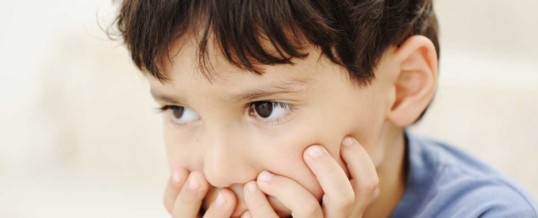
Student anxiety disorders are at an all-time high, making it increasingly important for teachers and other staff to know how to recognize and respond to students with anxiety.
Anxiety Statistics from the CDC
According to the Centers for Disease Control and Prevention (CDC), 7.1% of children aged 3-17 years (approximately 4.4 million) have diagnosed anxiety. Having another disorder is most common in children with depression: about 3 in 4 children aged 3-17 years with depression also have anxiety (73.8%), and almost 1 in 2 have behavior problems (47.2%).
Anxiety and Mental Health Problems: Anxiety is at an All-Time High
Anxiety is a primary human emotion. All children experience some form of anxiety. It can serve as a warning signal to the individual that something is not quite right within his or her environment.
Many children and youth experience facets of anxiety daily within school, home, and/or community. When anxiety is beyond what we would consider adjusting to normal daily difficulties, one may begin to show overt signs of stress.
These individuals may present as anxious, fearful, withdrawn, timid, depressed, to name a few. They may seem very unhappy, barely exhibit a smile, and demonstrate a lack of self-confidence.
One of the most challenging things educators face is deciding whether the anxiety displayed by a child or youth is typical for developmental age.
DSM-5 and Anxiety Disorders
The Diagnostic and Statistical Manual of Mental Disorders, Fifth Edition (DSM-5) describes a variety of anxiety disorders which includes separation anxiety disorder, selective mutism, specific phobia, social anxiety disorder (social phobia), panic disorder, panic attack specifier, agoraphobia, generalized anxiety disorder, medication-induced anxiety disorder, anxiety disorder due to another medical condition, other specified anxiety disorder, and unspecified anxiety disorder.
There are children and youth who experience a significant level of anxiety, but it does not meet the full criteria of the DSM-5 criteria.
Students and Anxiety by the Numbers
Studies have found that 40% of school-age students have fears of separation from their parents and/or guardians; 40 % of students aged 6 to 12 years have a significant amount of concerns that trouble them; 30 % worries about their competence in learning and life and require much loving reassurance; and 20 % of school-age children have phobias, fears, are shy in novel situations, anxious of public speaking, and most of all not being accepted socially by their peers.
Girls typically report more stressful and anxious feelings than boys, even though boys do suffer from similar concerns. Despite a student’s gender, 6 out of 10 children (59.3%) aged 3-17 years with anxiety do receive some form of mental health treatment.
Appropriate Training and Information Are the Hallmark to Treat Anxiety Disorders in Children and Youth
Educators with knowledge and information can begin to recognize the signs or symptoms of anxiety in their students. Each presents differently with symptoms and how they cope with them.
Common Signs Exhibited in the Classroom:
- Cries often
- Has fears of school
- Fear of performing terribly in school
- Must be perfect and no room for error
- Feels a sense of worthlessness
- Tense and nervous
- Feels too guilty
- Has difficulty with self-consciousness
- Feels slighted and hurt when given constructive feedback
- Mentions hints of suicide
- Is anxious to please others
- Worries often and ruminates on issues
Variety of Interventions for Anxiety Disorders
The overall goals of being vigilant to student Anxiety interventions are to teach the student to:
Recognize the signs of innate anxious arousal within him or herself; identify the cognitive processes connected to his or her anxious feelings, and help the student to employ their “plan” to cope and manage their anxiety.
Learn more about a Mental Health Certification today!
The Following are Suggested Approaches to Help a Student Experiencing Anxiety:
- Acquiring education and training about anxiety and mental health
- Being aware of physiological aspects of anxiety reaction such as flushing of the face, dilation of the pupils, sweating, hand tremors
- Encouraging relaxation procedures such as a cue-controlled relaxation using a word such as “calm” coupled with deep paced-breathing
- Helping the student recognize and modify anxious self-talk and anxious thinking
- Teaching problem-solving approaches by having the student included in the process
- Use role-playing with the student and provide positive reinforcement for good coping
- Provide homework assignments to all students in the classroom that incorporates problem-solving approaches of how one can cope with stressful situations
- Learn about the basics of pharmacological treatments involving medications such as SSRI’S (Selective Serotonin Reuptake Inhibitors) so one will be alert to positive and negative behavioral and emotional changes
- Work collaboratively with school mental health professionals such as the school psychologist, school social worker, school guidance counselor, school adjustment counselor.
Mental Health Certification is an Excellent Means of Gaining Additional Skills
Gaining the Mental Health Certification will provide training to assist educators in the classroom (and other school staff who interact with students) to understand what anxiety is, the cause, signs/behaviors, and how to assist students who may be struggling with anxiety.
The training can provide the educator with certification demonstrating a level of competence to help identify students earlier on who may be exhibiting signs of stress or acting out in another way. In turn, this would allow teachers to route those students to school mental health professionals or other resources before the anxiety and behavioral concerns are difficult to manage.
A Mental Health Certification through IBCCES will show the educator how to apply the latest best practices within the classroom.
By: Dr. Ann Marie Leonard-Zabel
Full Professor of Psychology-Curry College
President of NEALAC Clinic
Learn More About Mental Health Certifications
Fill out the form below to learn more about our SMHS and SMHC Programs.
APR